As the digital landscape evolves, businesses are constantly seeking innovative ways to drive store visits and enhance their online presence.
In 2024, Google Ads remains a pivotal tool for achieving these goals.
This article delves into five cutting-edge strategies to maximize store visits through Google Ads, offering a comprehensive guide for businesses aiming to thrive in the competitive digital marketplace.
Understanding the dynamics of Google Ads is crucial for any business looking to increase foot traffic to their physical locations.
With the right approach, Google Ads can not only boost store visits but also enhance overall brand visibility and customer engagement.
Let’s explore these strategies in detail, ensuring your business stays ahead in the ever-changing world of digital advertising.
- Understanding Smart Bidding for Enhanced Store Visits
- Leveraging Local Campaigns for Geo-Targeted Advertising
- Optimizing for Mobile Users to Drive Store Traffic
- Utilizing Video Ads to Enhance Engagement and Store Visits
- Exploring Advanced Audience Targeting Techniques
- Enhancing Ad Creatives for Maximum Impact
- Mastering Keyword Optimization for Targeted Reach
- Capitalizing on Google Shopping for In-Store Traffic
- Exploring the Power of Remarketing for Store Visits
- Maximizing the Impact of Ad Extensions on Store Visits
- Conclusion: Harnessing Google Ads for Enhanced Store Visits in 2024
- Frequently Asked Questions: Google Ad Strategies to Maximize Store Visits
Understanding Smart Bidding for Enhanced Store Visits
Smart Bidding in Google Ads has revolutionized how businesses target potential customers.
This AI-driven strategy optimizes your bids in real-time, focusing on users most likely to visit your store.
By analyzing vast amounts of data, Smart Bidding predicts which ad placements are most likely to result in actual store visits, ensuring your advertising budget is spent efficiently.
Implementing Smart Bidding requires a deep understanding of your target audience and business goals.
It’s essential to set clear objectives and monitor performance regularly to make necessary adjustments.
This strategy is particularly effective for businesses with physical locations, as it directly contributes to increasing foot traffic.
- Utilize historical data to inform your Smart Bidding strategy.
- Focus on conversion actions that are most relevant to in-store visits.
- Regularly review and adjust your bidding strategy based on performance metrics.
Tip: Combine Smart Bidding with high-quality ad creatives to maximize the impact of your campaigns.

Image illustrating geo-targeted advertising for local campaigns.
Leveraging Local Campaigns for Geo-Targeted Advertising
Local campaigns in Google Ads are a powerful way to reach potential customers in specific geographic locations.
By targeting users based on their proximity to your store, you can deliver highly relevant and timely ads that encourage store visits.
This approach is ideal for businesses with a strong local presence or those looking to expand into new areas.
Effective local campaigns require precise targeting and creative ad content that resonates with the local audience.
Highlighting local promotions, events, or unique store features can significantly increase the likelihood of attracting nearby customers.
- Target specific neighborhoods, towns, or districts relevant to your business.
- Use localized keywords and phrases like “near me” to capture high-intent searches.
- Create ad content that reflects local culture and preferences.
Idea: Utilize Google Maps integration in your local campaigns to guide customers directly to your store location.
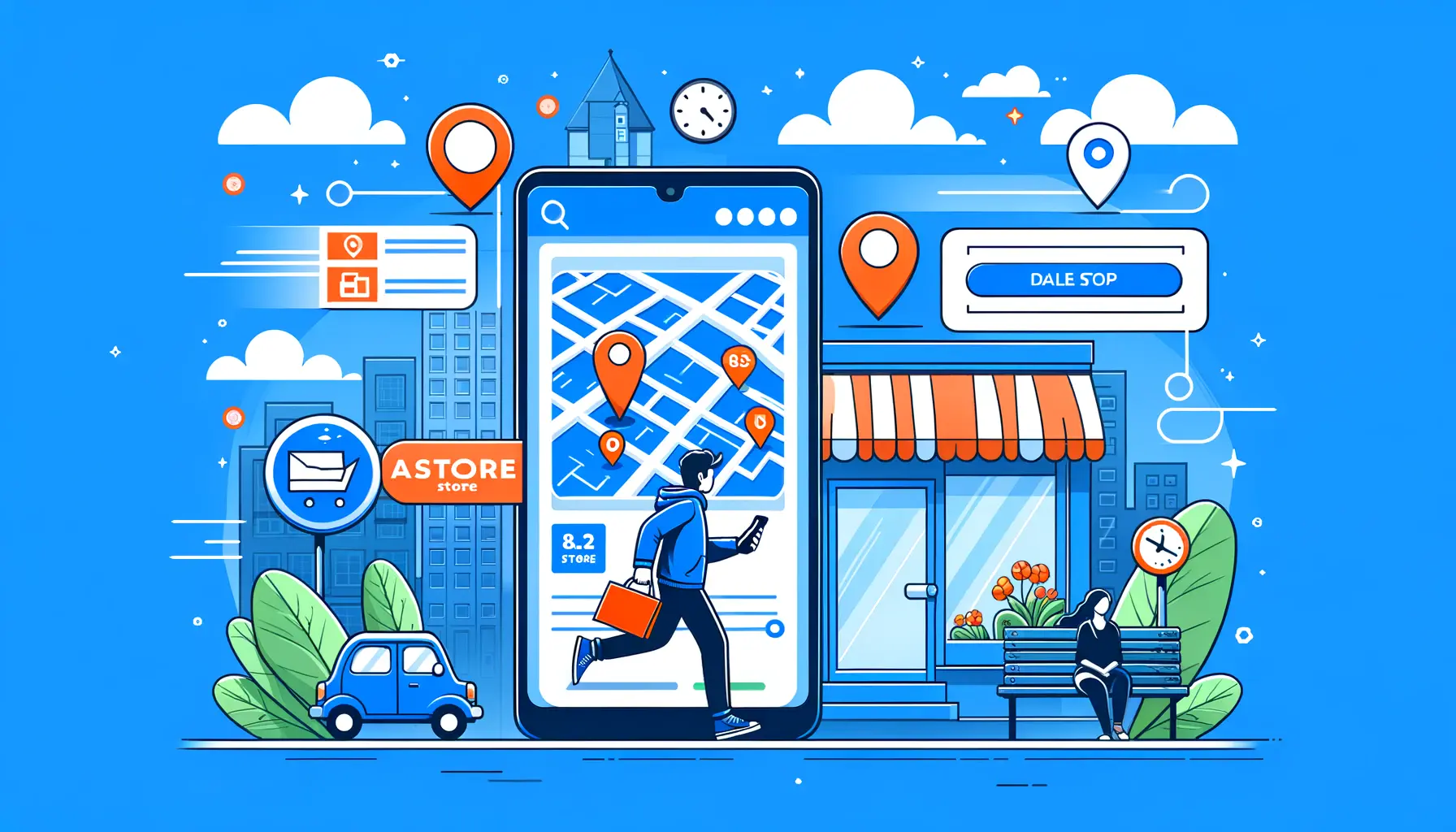
Image illustrating mobile optimization for driving store traffic.
Optimizing for Mobile Users to Drive Store Traffic
In 2024, the majority of online searches occur on mobile devices, making mobile optimization a critical component of any Google Ads strategy.
Mobile-optimized ads are designed to capture the attention of users on-the-go, offering them convenient solutions and driving them towards your physical store.
To effectively target mobile users, your ads should be concise, visually appealing, and easy to interact with on small screens.
Including clear calls-to-action and leveraging mobile-specific features like click-to-call can significantly enhance the effectiveness of your campaigns.
- Design ads with mobile users in mind, focusing on readability and engagement.
- Incorporate mobile-specific features like click-to-call buttons.
- Ensure your landing pages are mobile-friendly and load quickly.
Truth: Mobile-optimized ads can lead to higher engagement rates and increased store visits from users searching on their smartphones.
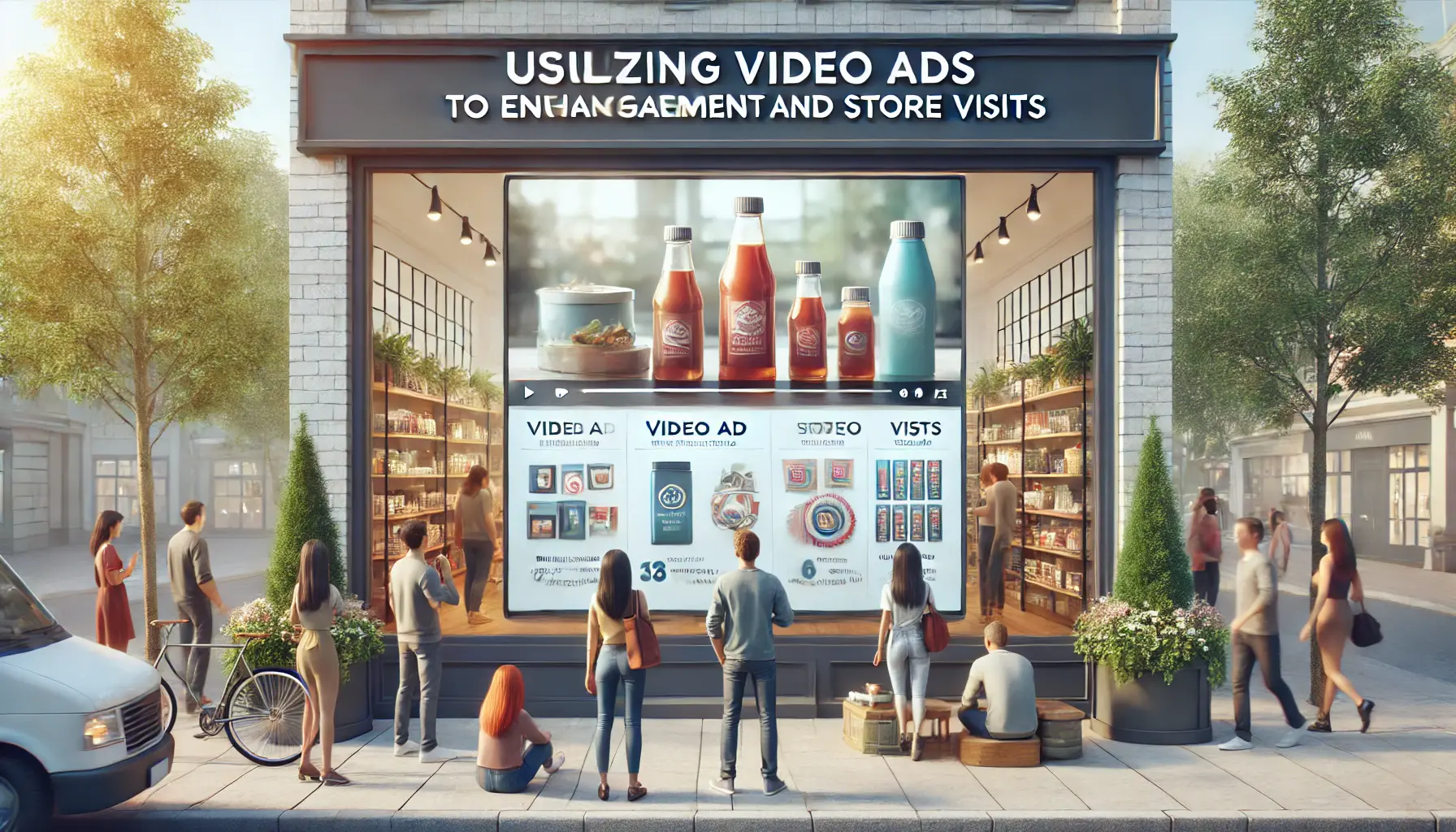
Image showcasing the use of video ads to boost engagement and drive store visits.
Utilizing Video Ads to Enhance Engagement and Store Visits
Video ads have emerged as a highly engaging format in Google Ads.
They offer a dynamic way to showcase your products or services, tell your brand’s story, and connect with your audience on an emotional level.
Well-crafted video ads can significantly increase brand recall and drive store visits.
When creating video ads, focus on storytelling and high-quality production.
Videos that tell a compelling story or demonstrate the value of your products in a relatable way are more likely to resonate with viewers and encourage them to visit your store.
- Create short, engaging videos that highlight your products or services.
- Use storytelling to connect with your audience and build brand affinity.
- Test different video formats and lengths to find what works best for your audience.
Note: Video ads can be used across various Google platforms, including YouTube, enhancing your reach and visibility.

Image showing a marketer refining ad targeting using advanced audience segmentation tools and analytics.
Exploring Advanced Audience Targeting Techniques
Advanced audience targeting in Google Ads allows you to reach specific segments of your target market with tailored messages.
By understanding your audience’s behaviors, interests, and demographics, you can create highly personalized ad campaigns that resonate with them and encourage store visits.
Utilize tools like Google’s in-market audiences, custom intent audiences, and remarketing lists to refine your targeting.
This approach ensures your ads are seen by people most likely to be interested in your products or services, increasing the chances of them visiting your store.
- Segment your audience based on their interests, behaviors, and demographics.
- Use custom intent audiences to target users actively searching for products or services like yours.
- Leverage remarketing to re-engage past visitors and customers.
False: Broad targeting is always the best strategy for maximizing store visits.
(In reality, precise targeting often yields better results.)

Image showing a creative team refining ad creatives for maximum impact using digital design tools.
Enhancing Ad Creatives for Maximum Impact
Creating compelling ad creatives is essential for capturing the attention of potential customers and encouraging them to visit your store.
In 2024, the effectiveness of your Google Ads largely depends on the quality and relevance of your ad creatives.
This involves not only the visual elements but also the messaging and overall user experience.
To maximize the impact of your ad creatives, focus on high-quality visuals, clear and engaging copy, and a strong call-to-action.
Ensure that your ads align with your brand identity and speak directly to your target audience’s needs and preferences.
- Use high-resolution images and videos that showcase your products or store.
- Develop ad copy that is clear, concise, and compelling.
- Include a strong call-to-action that motivates users to visit your store.
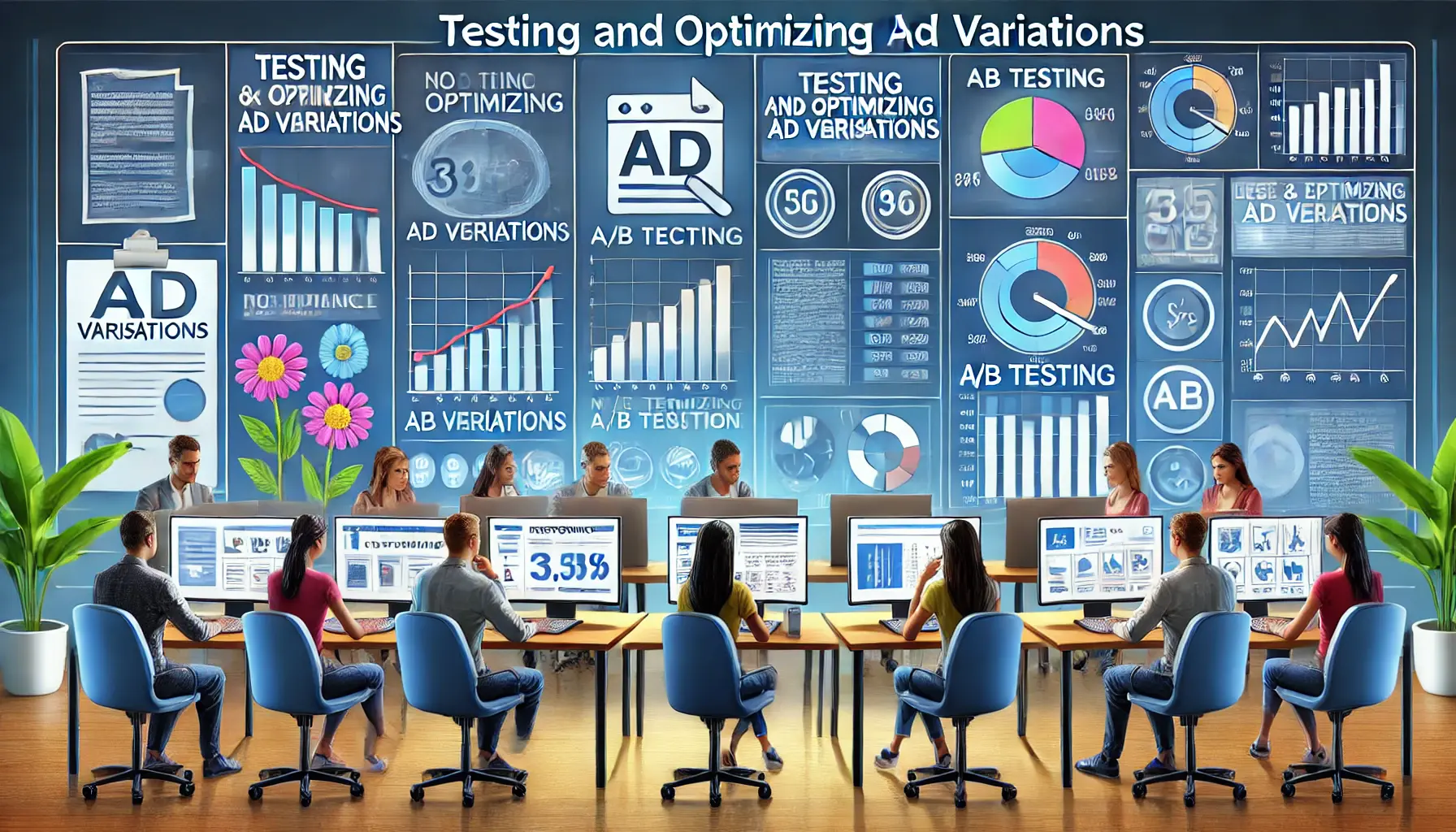
Image illustrating the process of testing and optimizing ad variations with performance analysis.
Testing and Optimizing Ad Variations
Testing different ad variations is crucial for understanding what resonates best with your audience.
A/B testing allows you to compare different versions of your ads to determine which elements are most effective in driving store visits.
Experiment with different headlines, descriptions, images, and calls-to-action.
Analyze the performance data to identify which variations yield the highest click-through and conversion rates.
Continuous testing and optimization are key to maintaining the effectiveness of your Google Ads campaigns over time.
- Conduct A/B tests to compare different ad elements.
- Analyze performance data to identify the most effective variations.
- Regularly update and optimize your ads based on testing results.
Featured: High-quality ad creatives combined with continuous testing and optimization can significantly increase the effectiveness of your Google Ads campaigns in driving store visits.

Image showing a retail store integrating seasonal and promotional campaigns with festive displays.
Integrating Seasonal and Promotional Campaigns
Seasonal and promotional campaigns are excellent opportunities to drive increased store visits.
Tailoring your Google Ads to align with holidays, seasons, or special events can capture the attention of consumers looking for relevant offers and experiences.
Plan your campaigns in advance to coincide with key shopping periods or local events.
Use seasonal themes, special offers, and time-sensitive calls-to-action to create a sense of urgency and encourage immediate store visits.
- Align your campaigns with holidays, seasons, and local events.
- Use seasonal themes and special offers to attract customers.
- Create time-sensitive calls-to-action to encourage immediate action.

Image illustrating the integration of cross-channel marketing strategies using multiple devices.
Utilizing Cross-Channel Marketing Strategies
Integrating your Google Ads with other marketing channels can amplify your reach and impact.
Cross-channel marketing allows you to create a cohesive brand experience across multiple platforms, increasing the likelihood of driving store visits.
Leverage social media, email marketing, and your website in conjunction with your Google Ads.
Ensure consistent messaging and branding across all channels to build a strong, unified brand presence.
- Coordinate your Google Ads with social media, email, and website marketing.
- Ensure consistent messaging and branding across all channels.
- Use cross-channel data to inform and optimize your Google Ads strategy.

Image illustrating the process of mastering keyword optimization for targeted marketing reach.
Mastering Keyword Optimization for Targeted Reach
Keywords are the cornerstone of any successful Google Ads campaign, especially when the goal is to maximize store visits.
In 2024, the art of keyword optimization involves not just selecting the right keywords but also understanding the intent behind them.
This ensures that your ads are displayed to users who are most likely to visit your store.
Focus on keywords that are closely related to your products, services, and location.
Utilize long-tail keywords that capture specific search intents and are less competitive, yet highly effective in attracting a targeted audience.
- Research and select keywords that are highly relevant to your business and location.
- Incorporate long-tail keywords to target specific search intents.
- Regularly update and refine your keyword list based on performance and trends.

Image depicting the analysis of user search intent to optimize marketing strategies.
Understanding User Search Intent
Understanding user search intent is crucial in tailoring your keywords and ad messages.
Keywords can be categorized based on the type of intent, such as informational, navigational, transactional, or local.
Aligning your keywords with the correct user intent increases the chances of your ads being seen by potential customers who are ready to visit your store.
Analyze search trends and user behavior to gain insights into the types of queries that lead to store visits.
Tailor your ad content to match these intents, providing clear and direct paths to your store.
- Analyze search trends to understand different types of user intent.
- Match your keywords and ad content with the correct user intent.
- Provide clear and direct information in your ads to guide users to your store.

Image illustrating the process of optimizing a local business listing for better visibility in local SEO.
Optimizing for Local SEO
Local SEO plays a significant role in driving store visits through Google Ads.
Optimize your ads for local searches by including location-specific keywords and phrases.
Ensure your Google My Business profile is up-to-date and integrates seamlessly with your ads, providing users with essential information like your store address, hours, and contact details.
Local SEO not only helps in improving ad visibility in local searches but also enhances the overall user experience by providing relevant and useful information to potential customers in your vicinity.
- Include location-specific keywords in your ads.
- Ensure your Google My Business profile is accurate and comprehensive.
- Use local SEO to improve visibility and relevance in local search results.

Image illustrating the process of adapting to changing search trends and evolving user behavior.
Adapting to Changing Search Trends
The digital landscape is constantly evolving, and so are search trends.
Staying abreast of these changes and adapting your keyword strategy accordingly is essential for maintaining the effectiveness of your Google Ads campaigns.
Regularly monitor search trends, competitor strategies, and industry developments.
Be agile in updating your keywords and ad content to reflect current trends and user preferences, ensuring your ads remain relevant and effective in driving store visits.
- Monitor and adapt to changing search trends and user preferences.
- Update your keywords and ad content regularly to stay relevant.
- Keep an eye on competitor strategies and industry developments.

Image illustrating the use of Google Shopping to drive in-store traffic by showcasing product listings and customer interactions.
Capitalizing on Google Shopping for In-Store Traffic
Google Shopping has become an indispensable tool for retailers looking to drive both online and in-store traffic.
In 2024, leveraging Google Shopping campaigns effectively can significantly increase store visits by showcasing your products directly in search results.
These visually appealing ads provide users with key information at a glance, encouraging them to visit your store for a closer look or purchase.
To make the most of Google Shopping, ensure your product listings are detailed, accurate, and up-to-date.
High-quality images, competitive pricing, and clear product descriptions can make your listings stand out in the crowded online marketplace.
- Optimize product listings with high-quality images and detailed descriptions.
- Keep pricing competitive and transparent in your Google Shopping ads.
- Regularly update your inventory to reflect current availability and new arrivals.

Image illustrating the integration of online and offline shopping experiences in a modern retail environment.
Integrating Online and Offline Shopping Experiences
In today’s retail landscape, the line between online and offline shopping is increasingly blurred.
Integrating your online Google Shopping campaigns with your physical store experience can create a seamless journey for customers.
Use online ads to highlight in-store exclusive products or promotions, encouraging online browsers to visit your store in person.
Consider offering special incentives for customers who have viewed your products online to visit your store, such as exclusive in-store discounts or first-access to new products.
- Highlight in-store exclusives and promotions in your online ads.
- Offer incentives for online viewers to visit your physical store.
- Create a seamless shopping experience from online browsing to in-store purchasing.

Image illustrating the use of local inventory ads to enhance in-store shopping experiences.
Utilizing Local Inventory Ads
Local Inventory Ads are a powerful feature within Google Shopping that allows businesses to showcase products available in nearby stores.
This feature is particularly useful for driving foot traffic, as it targets users searching for products in their vicinity.
Ensure your local inventory is accurately reflected in these ads to attract nearby customers looking for immediate availability.
These ads can also include store information such as location, hours, and contact details, making it easier for potential customers to visit your store.
- Use Local Inventory Ads to showcase products available in nearby stores.
- Ensure accurate and up-to-date local inventory information.
- Include store details in ads to facilitate in-store visits.
Image illustrating the process of tracking and analyzing shopping ad performance to optimize campaigns.
Tracking and Analyzing Shopping Ad Performance
Tracking the performance of your Google Shopping ads is crucial for understanding their impact on store visits.
Utilize Google’s analytics tools to monitor metrics such as click-through rates, conversion rates, and in-store visits attributed to your ads.
This data can provide valuable insights into customer behavior and preferences, helping you refine your campaigns for maximum effectiveness.
Analyze which products are driving the most store visits and adjust your inventory and marketing strategies accordingly.
Continuously optimizing your Google Shopping campaigns based on performance data can lead to sustained growth in store traffic.
- Monitor key performance metrics of your Google Shopping ads.
- Analyze customer behavior and preferences to refine your campaigns.
- Optimize inventory and marketing strategies based on ad performance data.

Image illustrating the power of remarketing campaigns aimed at driving store visits.
Exploring the Power of Remarketing for Store Visits
Remarketing in Google Ads is a potent strategy for businesses aiming to increase store visits.
By targeting users who have previously interacted with your website or app, remarketing campaigns can remind and encourage them to visit your physical store.
This approach is highly effective as it reaches an audience already familiar with your brand and products.
To implement successful remarketing campaigns, segment your audience based on their previous interactions with your brand.
Tailor your ad content to reflect their interests and past behavior, making your ads more relevant and compelling.
- Create audience segments based on previous website or app interactions.
- Develop tailored ad content that resonates with each audience segment.
- Use remarketing to remind users of their interest in your products and encourage store visits.

Image illustrating the seamless connection between online browsing and offline purchases.
Combining Online Interactions with Offline Conversions
Remarketing offers the unique opportunity to bridge the gap between online interactions and offline conversions.
By analyzing the online behavior of users who visit your store, you can refine your remarketing strategies to target similar users more effectively.
This approach helps in creating a cohesive marketing strategy that encompasses both online and offline customer journeys.
Utilize data from both online interactions and in-store visits to gain a comprehensive understanding of your customer’s journey.
This integrated approach can significantly enhance the effectiveness of your remarketing campaigns in driving store visits.
- Analyze data from both online interactions and offline store visits.
- Refine remarketing strategies based on comprehensive customer journey insights.
- Create cohesive marketing strategies that encompass online and offline experiences.
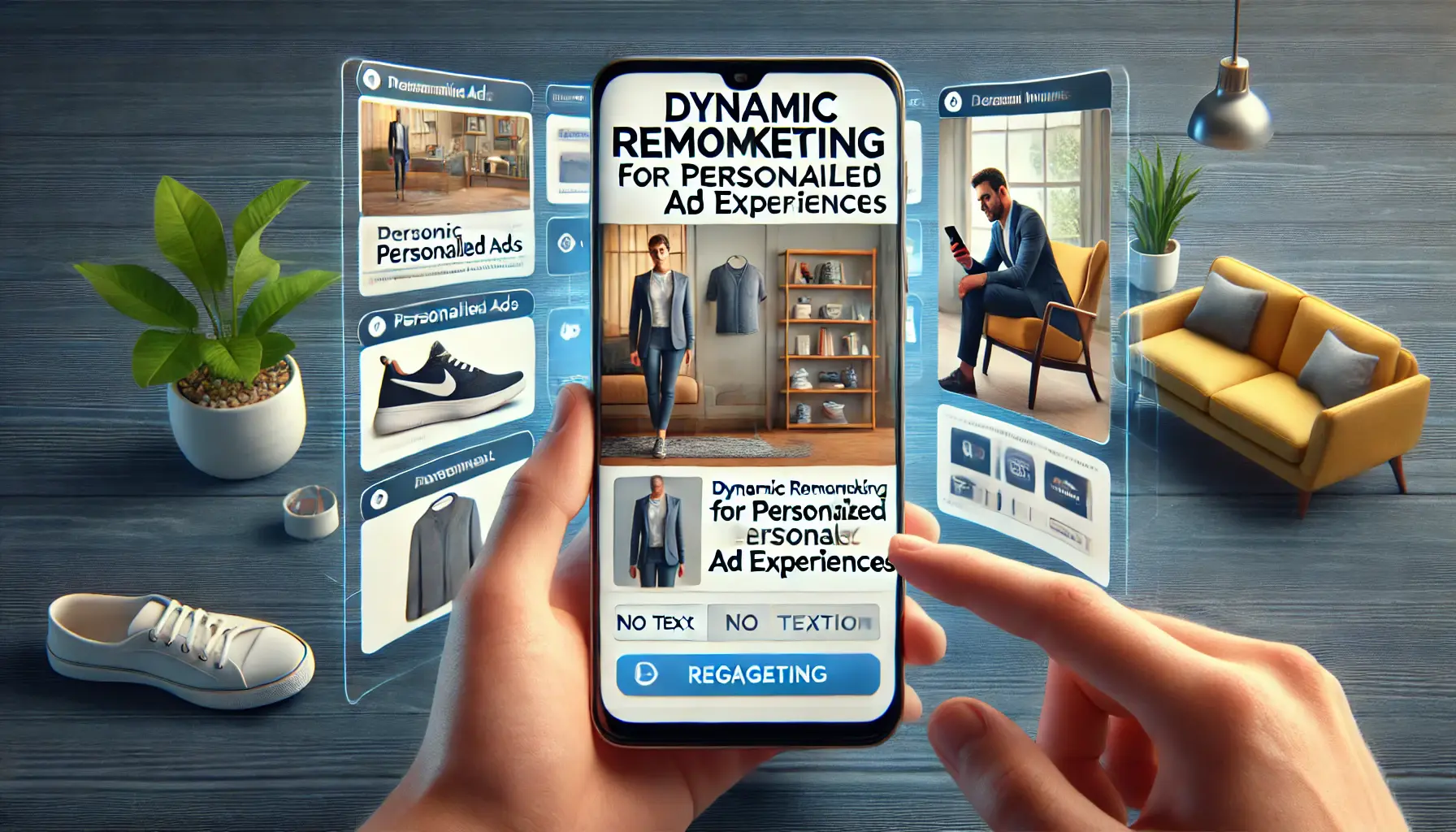
Image illustrating dynamic remarketing with personalized ads targeting customers based on previous interactions.
Dynamic Remarketing for Personalized Ad Experiences
Dynamic remarketing takes personalization to the next level by displaying ads that feature products or services users have previously viewed on your website.
This highly targeted approach can be particularly effective in reminding users about their interests and nudging them towards visiting your store to make a purchase.
Ensure your dynamic remarketing ads are visually appealing and include up-to-date information about the products featured.
Personalized messaging can further enhance the relevance of these ads, increasing the likelihood of converting online interest into offline store visits.
- Use dynamic remarketing to show ads featuring previously viewed products.
- Ensure ads are visually appealing and include current product information.
- Incorporate personalized messaging to enhance ad relevance.
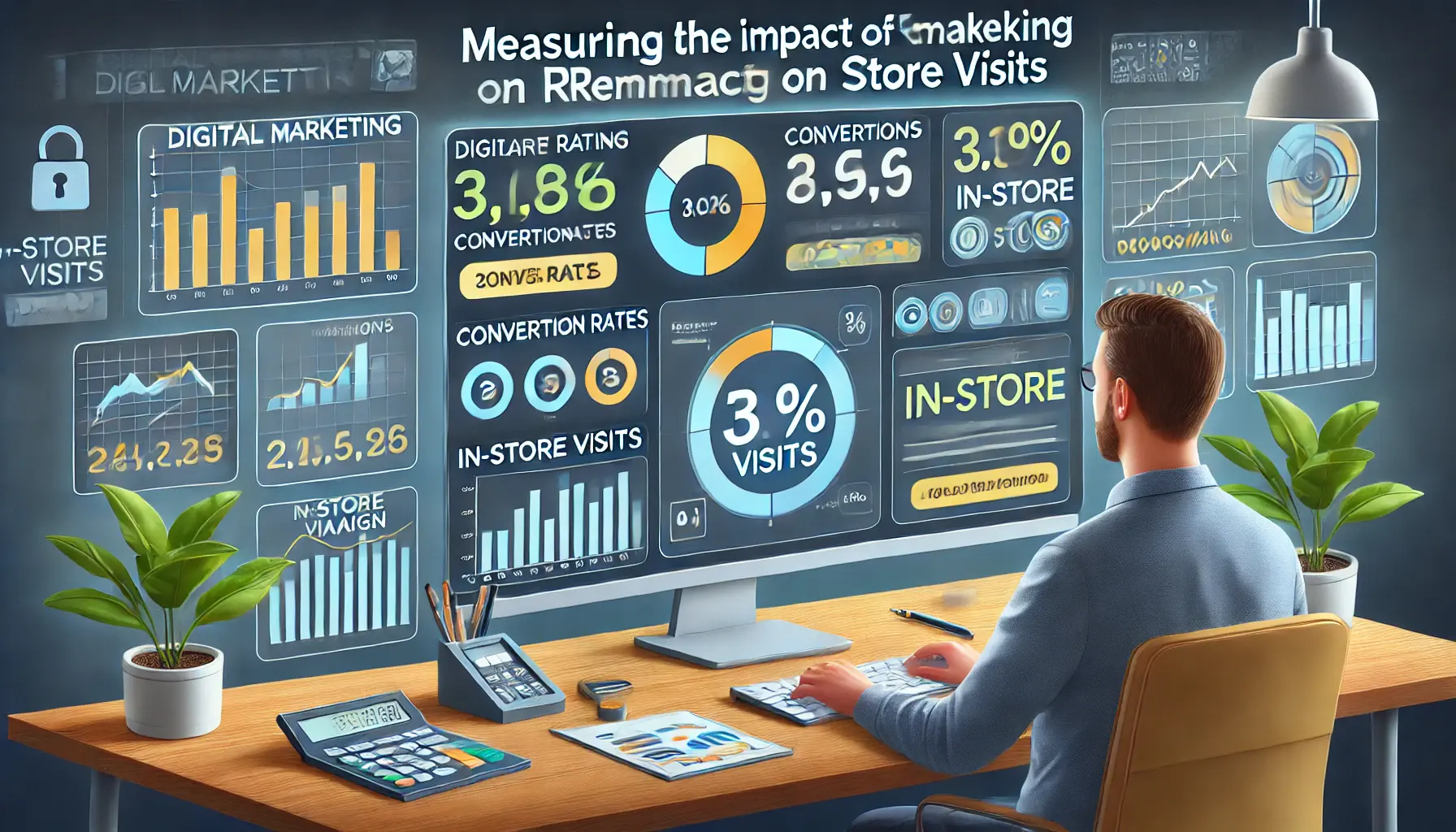
Image illustrating the process of measuring the impact of remarketing on driving store visits with performance data.
Measuring the Impact of Remarketing on Store Visits
Measuring the impact of your remarketing campaigns on store visits is crucial for understanding their effectiveness and ROI.
Utilize Google Ads’ conversion tracking tools to monitor how many users who clicked on your remarketing ads visited your store.
This data can provide valuable insights into the effectiveness of your campaigns and guide future marketing strategies.
Analyze the data to understand which aspects of your remarketing campaigns are driving the most store visits.
Continuously optimize your campaigns based on these insights to maximize their impact on driving foot traffic to your store.
- Use Google Ads’ conversion tracking to measure the impact of remarketing on store visits.
- Analyze data to understand which campaign elements are most effective.
- Continuously optimize remarketing campaigns based on performance insights.

Image illustrating the optimization of ad extensions like location, call, and promotion for driving store visits.
Maximizing the Impact of Ad Extensions on Store Visits
Ad extensions in Google Ads are a powerful feature that can significantly enhance the visibility and effectiveness of your ads.
By providing additional information and interactive elements, ad extensions can make your ads more appealing and informative, leading to increased store visits.
In 2024, utilizing ad extensions strategically is more important than ever for businesses looking to drive foot traffic.
Choose ad extensions that are most relevant to your business and goals.
Location extensions, call extensions, and promotion extensions are particularly useful for driving store visits.
They provide users with easy access to your store details, contact information, and special offers.
- Utilize location extensions to display your store address and directions.
- Implement call extensions to enable direct phone calls to your store.
- Use promotion extensions to highlight special offers and discounts.
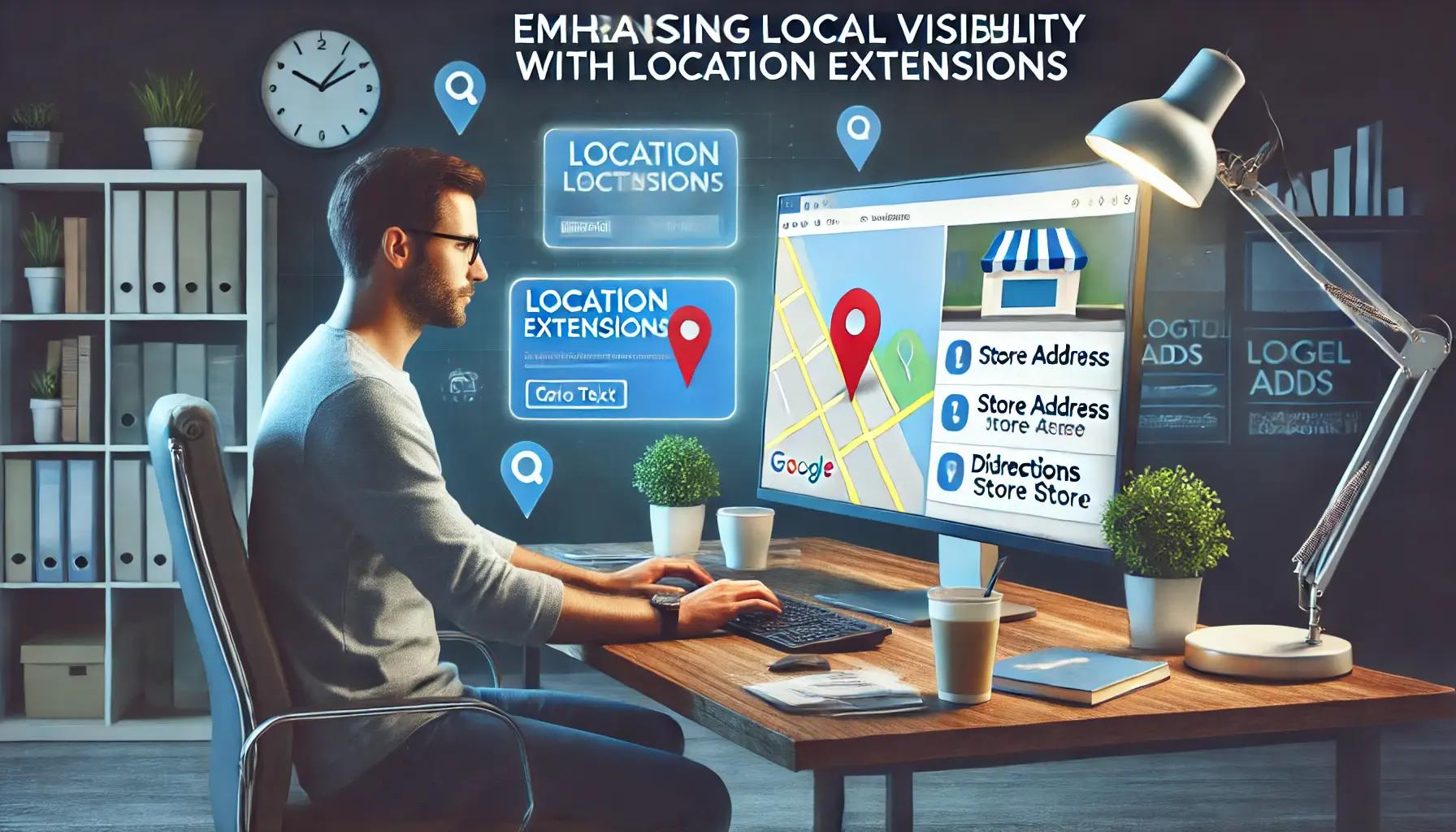
Image illustrating the use of location extensions to enhance local visibility in Google Ads campaigns.
Enhancing Local Visibility with Location Extensions
Location extensions are essential for businesses aiming to increase store visits.
They allow your ads to display your store’s address, phone number, and a map marker, making it easier for potential customers to find your physical location.
This extension is particularly effective for local businesses and can significantly improve local search visibility.
Ensure your location details are accurate and up-to-date in your Google My Business account, as this information is used for location extensions in your ads.
- Keep your Google My Business information accurate for effective location extensions.
- Use location extensions to improve visibility in local searches.
- Make it easy for potential customers to find and visit your store.

Image illustrating the use of call extensions to drive immediate responses in a marketing campaign.
Driving Immediate Responses with Call Extensions
Call extensions add a phone number to your ads, allowing potential customers to contact your store directly from the ad.
This feature is particularly useful for mobile users who can call with just a tap.
Call extensions can drive immediate responses and are effective in industries where personal contact is important, such as services or high-value product sales.
Monitor call data to understand the effectiveness of these extensions in driving store visits and customer engagement.
- Add call extensions to encourage immediate contact from potential customers.
- Optimize for mobile users with easy tap-to-call functionality.
- Analyze call data to gauge the impact on store visits and customer engagement.
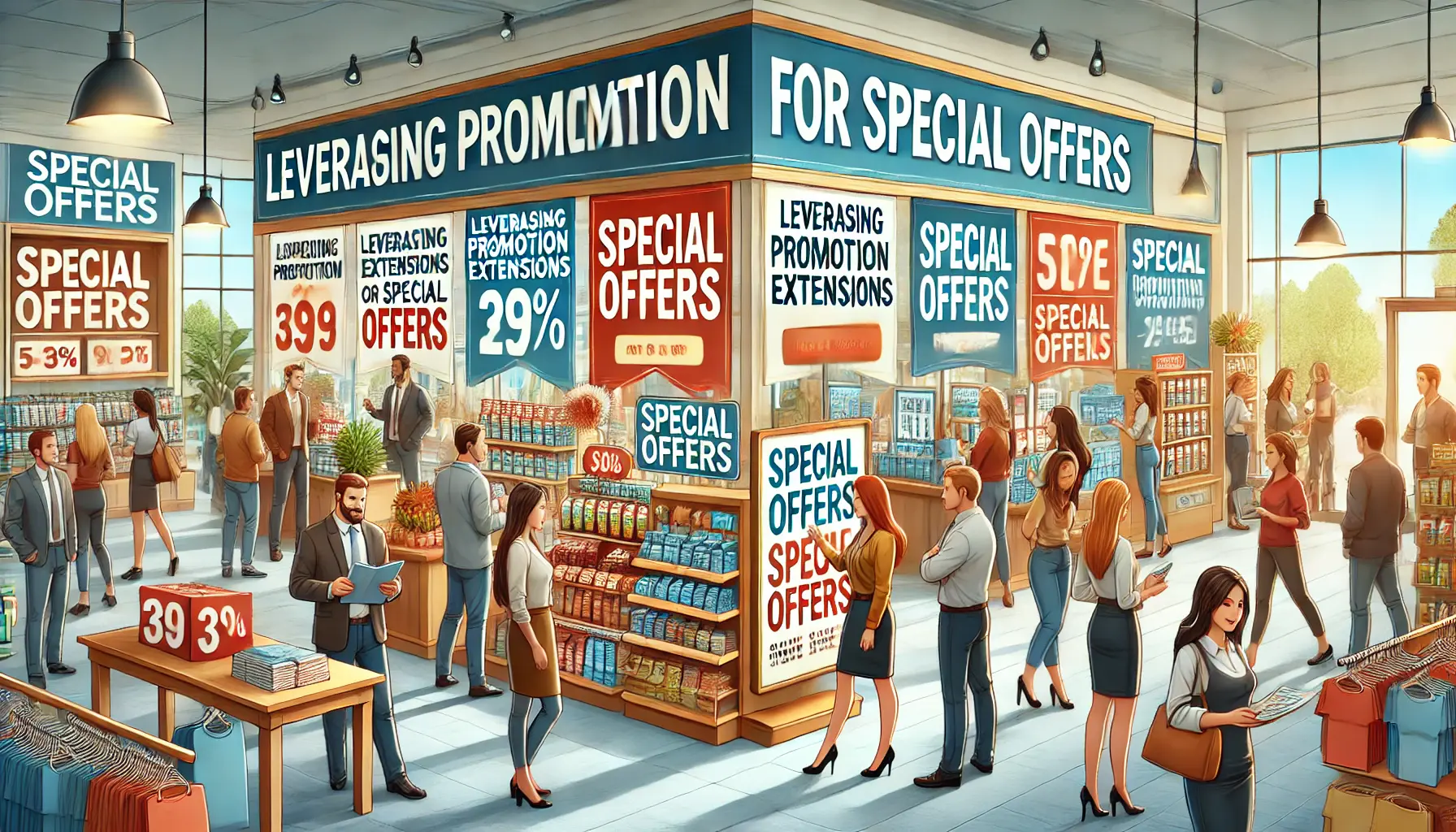
Image illustrating the use of promotion extensions to highlight special offers in a retail environment.
Leveraging Promotion Extensions for Special Offers
Promotion extensions allow you to highlight special offers, sales, or discounts directly in your ads.
This can be a powerful incentive for customers to visit your store, especially during key shopping periods or promotional events.
Clearly display the offer details to attract attention and encourage store visits.
Use promotion extensions strategically to align with your sales calendar, ensuring your offers are timely and relevant to your target audience.
- Highlight special offers and discounts with promotion extensions.
- Align offers with key shopping periods and promotional events.
- Use clear and compelling messaging to attract potential customers.
Image illustrating the analysis and tracking of extension performance for continuous ad campaign improvement.
Tracking Extension Performance for Continuous Improvement
Tracking the performance of your ad extensions is crucial for understanding their impact on store visits and overall campaign effectiveness.
Analyze metrics such as click-through rates and conversion rates to gauge how different extensions contribute to your goals.
Regularly review and optimize your ad extensions based on performance data.
This continuous improvement approach ensures your ads remain effective in driving store visits and achieving your business objectives.
- Analyze performance metrics of ad extensions to understand their impact.
- Regularly review and optimize extensions based on data insights.
- Ensure ad extensions contribute effectively to driving store visits.

Image illustrating the success of using Google Ads to drive increased store visits and campaign success in 2024.
Conclusion: Harnessing Google Ads for Enhanced Store Visits in 2024
In the dynamic world of digital marketing, mastering Google Ads is essential for businesses looking to maximize store visits.
The strategies discussed in this article provide a comprehensive roadmap for leveraging Google Ads to drive foot traffic and enhance customer engagement.
By understanding and implementing these tactics, businesses can effectively navigate the digital landscape and achieve substantial growth in store visits.

Image illustrating a collaborative session focused on strategies to maximize store visits using key campaign takeaways.
Key Takeaways for Maximizing Store Visits
As we move forward into 2024, the importance of adapting to evolving digital trends cannot be overstated.
The strategies outlined offer a blend of innovative and time-tested approaches, each contributing uniquely to driving store visits:
- Smart Bidding and Local Campaigns: These strategies emphasize the importance of targeted advertising, ensuring that your ads reach the most relevant audience.
- Mobile Optimization and Video Ads: Catering to the growing number of mobile users and utilizing engaging video content can significantly enhance ad effectiveness.
- Advanced Audience Targeting: By understanding and segmenting your audience, you can create personalized ad experiences that resonate with potential customers.
- Google Shopping and Remarketing: These tools are invaluable for bridging the gap between online browsing and offline store visits.
- Ad Extensions: Utilizing various ad extensions can provide additional information and interactive elements to attract and engage potential customers.
Each of these strategies plays a crucial role in creating a comprehensive Google Ads campaign that not only reaches a wide audience but also effectively converts online interest into physical store visits.
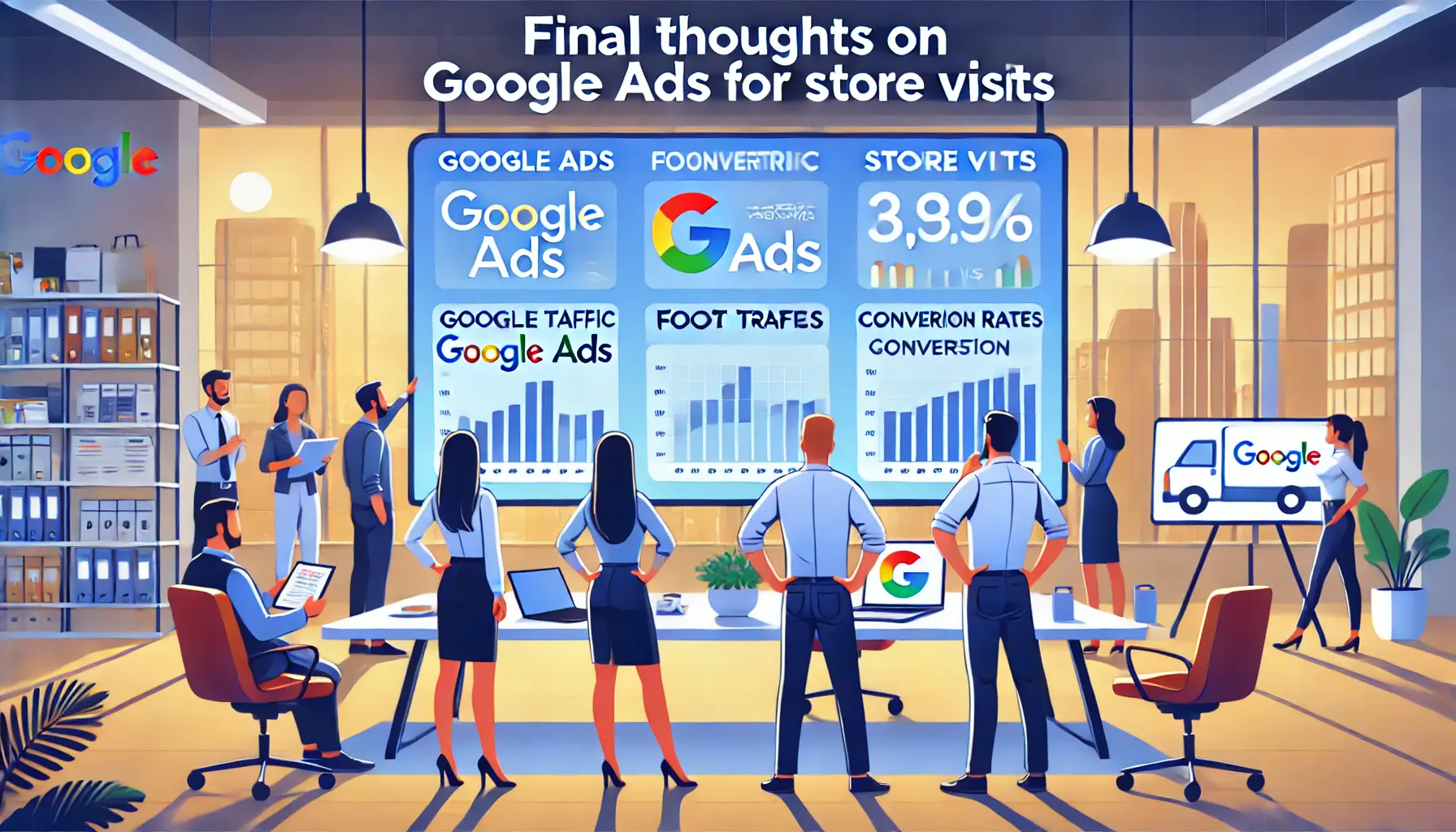
Image illustrating the reflection and conclusion of successful Google Ads campaigns driving store visits.
Final Thoughts on Google Ads for Store Visits
As we look towards the future, the potential of Google Ads in driving store visits remains immense.
The key to success lies in understanding your audience, staying abreast of digital trends, and continuously optimizing your campaigns.
By embracing these strategies, businesses can unlock the full potential of Google Ads, turning digital interactions into real-world store visits and fostering long-term customer relationships.
In conclusion, the journey to maximize store visits through Google Ads is an ongoing process of learning, adapting, and innovating.
By staying committed to these principles, businesses can not only survive but thrive in the competitive digital marketplace of 2024 and beyond.
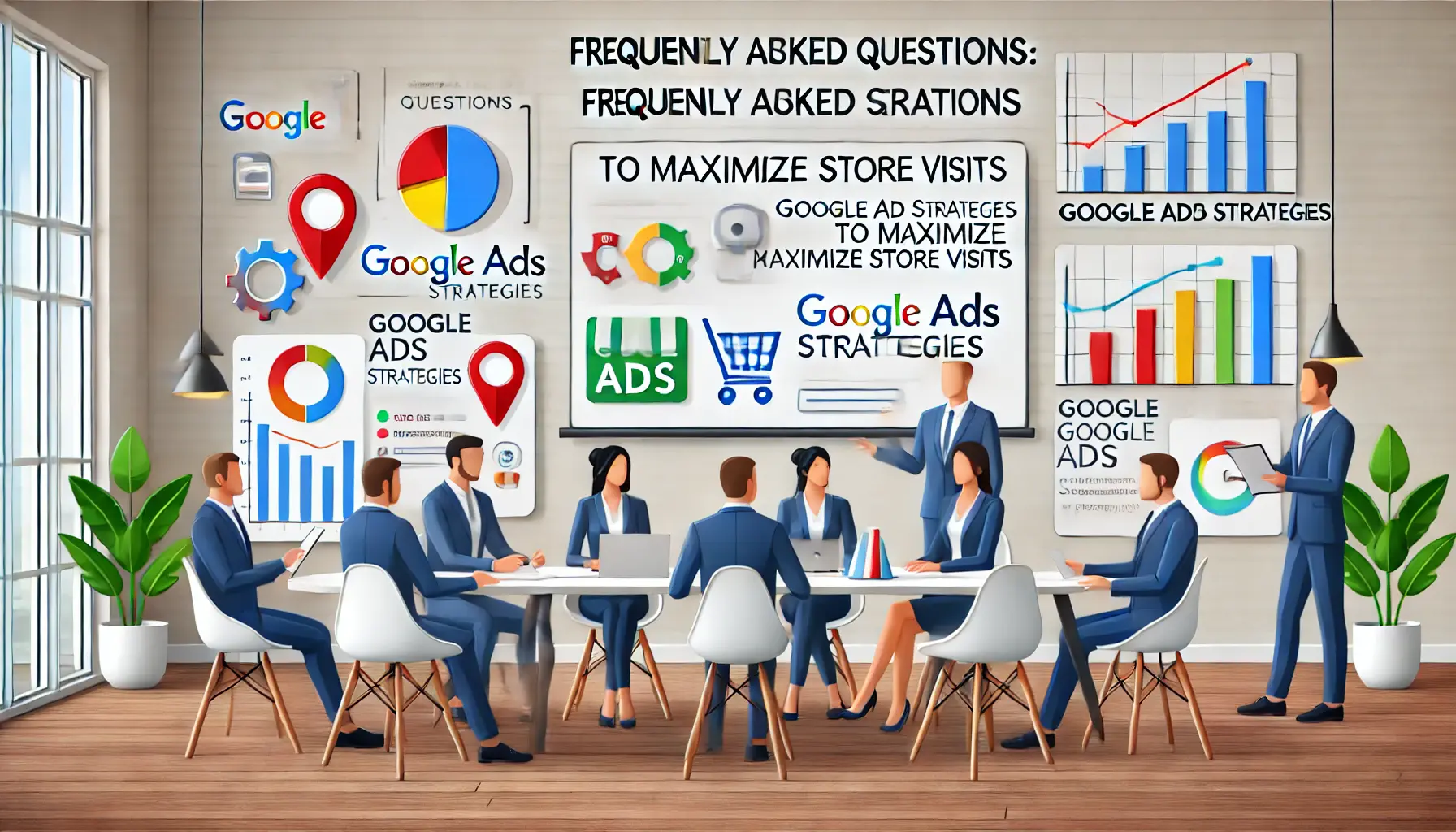
Image illustrating a team of digital marketers discussing Google Ads strategies and addressing frequently asked questions.
Your campaigns can be managed by an agency specialized in Google Ads, check out our service page.
Frequently Asked Questions: Google Ad Strategies to Maximize Store Visits
Explore these FAQs to deepen your understanding of how Google Ads can be optimized to increase store visits in 2024.
Smart Bidding strategies for store visits use AI to optimize bids in real-time, targeting users most likely to visit your store based on their online behavior and preferences.
Google Ads can enhance omnichannel performance by optimizing campaigns across online and offline channels, ensuring a cohesive and effective marketing strategy.
Yes, Google Ads can effectively drive foot traffic to physical stores by targeting local audiences and using strategies like Local Campaigns and Smart Bidding.
Smart Bidding plays a crucial role by optimizing ad bids to target users who are most likely to visit a store, enhancing the efficiency of ad spend.
Local Campaigns in Google Ads target potential customers within a specific geographic area, increasing ad relevance and likelihood of store visits.
Google Ads are versatile and can be effective for various business types, especially when tailored to specific goals like increasing store visits.
In 2024, Google Ads’ advanced targeting and optimization capabilities make it crucial for businesses looking to increase store visits and customer engagement.
Promotion extensions in Google Ads highlight special offers or discounts in ads, creating a compelling incentive for customers to visit physical stores.









